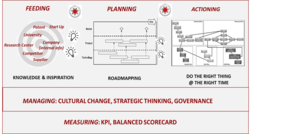L'Ideation rate per un processo innovativo di successo

Una recente ricerca statunitense pubblicata su Harvard Business Review ha indicato come il rapporto fra il numero d'idee approvate dal management e il numero delle persone che partecipano alla generazione delle stesse (Ideation rate), possa essere considerato un elemento chiave di un processo innovativo di successo.
Questo è uno dei molteplici criteri per sistematizzare e misurare il processo d'innovazione. Essere innovativi in modo efficiente significa valutare un'idea secondo i propri obiettivi strategici, definendone il potenziale e l’effettiva realizzazione e confrontarsi con best practice anche di altri settori, utilizzando tutte le risorse, le infrastrutture e i processi necessari per raggiungere i target d'innovazione fissati.
Ideation rate: quali sono le variabili che lo influenzano e come fare a guidarle?
(...) innovation, like marketing and sales, is a pipeline. In one end go raw concepts and notions. Out the other end come actionable ideas that can move the business forward. With the right technology, could you manage this pipeline the way you manage a sales pipeline?
(...) Our research...has analyzed five years of data from 154 public companies covering over 3.5 million employees (...). For the millions of employees of these companies, the idea management system functions a little like Facebook – people can post ideas, get votes, deliver or respond to feedback, and develop the ideas into innovations that make a difference to the company. The innovation teams at these companies use them to track and process all the ideas and whether the company committed to putting them into practice. Some companies use (...) for process innovation; others develop new products; others seek efficiencies and cost savings.
(...) know how many innovation challenges the companies are running, how many people are suggesting ideas, and how many ideas they suggest. We know how many people are participating in other ways – by voting or making comments, for example. And we also know how many of those ideas get through the endpoint of the challenge, which is where the company’s management determines which ideas to pursue further. (...)
But what we learned from our analysis of all this data is that innovation is, indeed, a science. And surprisingly, the variables that make for a successful innovation program are independent of whether the company is seeking disruptive or incremental innovations. It doesn’t matter whether they’re asking for process or product innovation, what industry the company is in, or even, for the most part, whether the company is large or small.
The key variable that we identified across all the companies in our analysis is the ideation rate, which we define as the number of ideas approved by management divided by the total number of active users in the system. Higher ideation rates are correlated with growth and net income, most likely because companies with an innovation culture not only generate better ideas, but are organized and managed to act on them.
After reviewing dozens of variables that could potentially affect ideation, we identified four that drove the ideation rate. (...)
- Scale – more participants. To succeed, an innovation program needs lots of participants. (...) On average, companies generate one idea for every four participants in the system.
- Frequency – more ideas. To get to a set of promising ideas whose implementation would make sense, you need to sift through a lot of candidates. To succeed, a company needs to create frequent idea challenges for its employees. These challenges reinforce a culture of innovation and generate more ideas going into the pipeline. While there is a great deal of variation based on the types of ideas and the companies reviewing them, on average, it takes five idea candidates to generate one idea that the company judges to be worth implementing.
- Engagement – more people evaluating ideas. It’s not enough to get some people suggesting ideas. You need lots of other people figuring out whether those ideas are worth working on, or what it will take for them to become better. (...)
- Diversity – more kinds of people contributing. (...) A successful system needs contributions from all over the organization, especially staff who are close to the front lines: sales staff, support workers, or people in close touch with the company’s manufacturing processes, for example.
When a program like this is working, it churns out actionable innovations at a steady and predictable pace. (...) But when you treat ideas systematically with an appropriately designed system, you can manage the pipeline of those ideas. That pipeline engages the employees who best know how to solve the problems of the business, and generates a predictable stream of innovations. Those innovations drive the business forward. (...)
Fonte: Harvard Business Review
Per informazioni sui criteri per misurare il processo innovativo scrivi a stratinnov@stratinnov.it
Partecipa a Gestire e misurare l'innovazione 10 ottobre 2018


